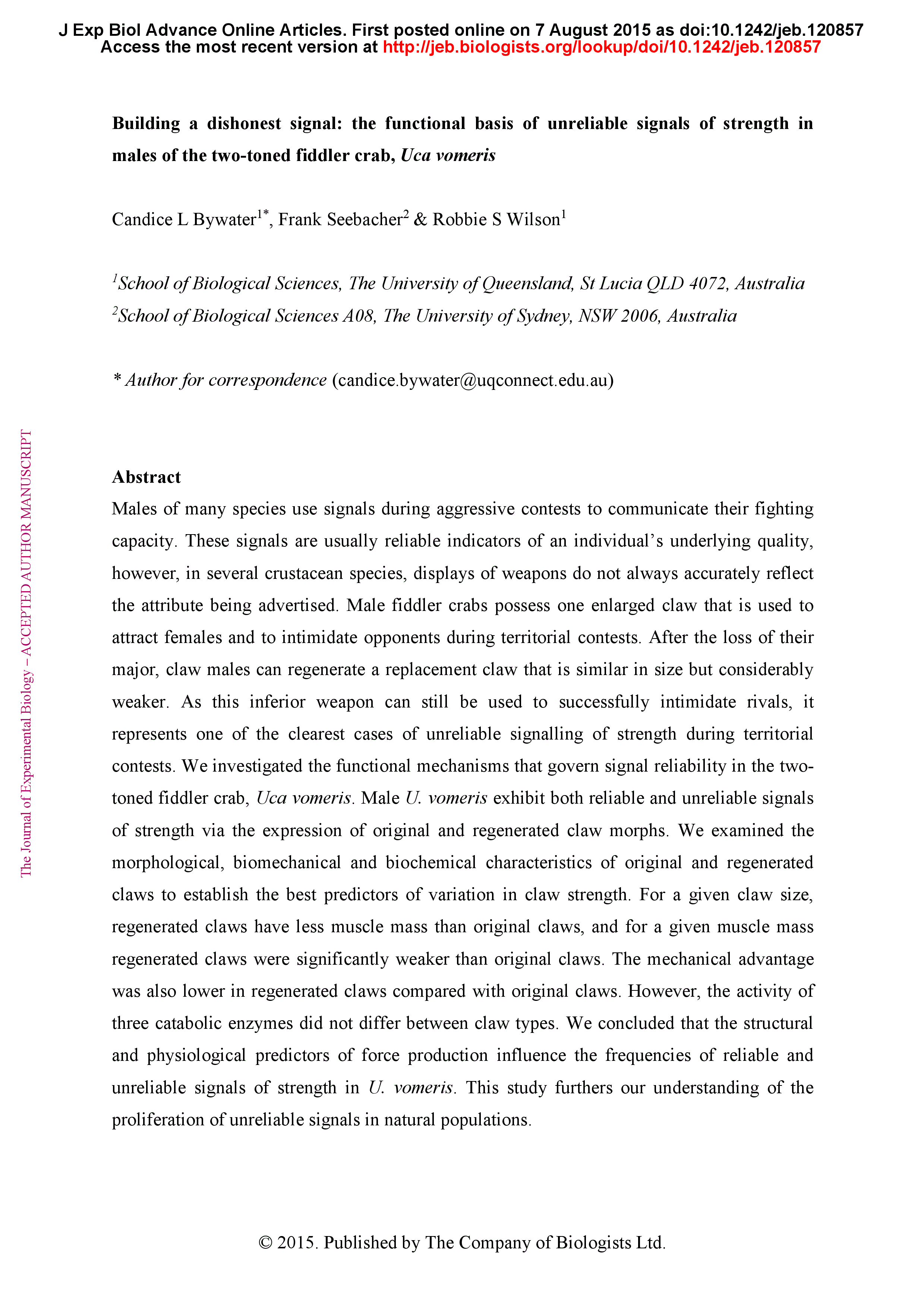Males of many species use signals during aggressive contests to communicate their fighting capacity. These signals are usually reliable indicators of an individual's underlying quality, however, in several crustacean species, displays of weapons do not always accurately reflect the attribute being advertised. Male fiddler crabs possess one enlarged claw that is used to attract females and to intimidate opponents during territorial contests. After the loss of their major, claw males can regenerate a replacement claw that is similar in size but considerably weaker. As this inferior weapon can still be used to successfully intimidate rivals, it represents one of the clearest cases of unreliable signalling of strength during territorial contests. We investigated the functional mechanisms that govern signal reliability in the two-toned fiddler crab, Uca vomeris. Male U. vomeris exhibit both reliable and unreliable signals of strength via the expression of original and regenerated claw morphs. We examined the morphological, biomechanical and biochemical characteristics of original and regenerated claws to establish the best predictors of variation in claw strength. For a given claw size, regenerated claws have less muscle mass than original claws, and for a given muscle mass regenerated claws were significantly weaker than original claws. The mechanical advantage was also lower in regenerated claws compared with original claws. However, the activity of three catabolic enzymes did not differ between claw types. We concluded that the structural and physiological predictors of force production influence the frequencies of reliable and unreliable signals of strength in U. vomeris. This study furthers our understanding of the proliferation of unreliable signals in natural populations.
Building a dishonest signal: the functional basis of unreliable signals of strength in males of the two-toned fiddler crab, Uca vomeris
Currently Viewing Accepted Manuscript - Newer Version Available
Candice L. Bywater, Frank Seebacher, Robbie S. Wilson; Building a dishonest signal: the functional basis of unreliable signals of strength in males of the two-toned fiddler crab, Uca vomeris. J Exp Biol 2015; jeb.120857. doi: https://doi.org/10.1242/jeb.120857
Download citation file:
Advertisement
2023 JEB Outstanding Paper Prize shortlist and winner

The JEB Editors are delighted to announce the shortlisted authors for the 2023 JEB Outstanding Paper Prize. Read the winning paper - Tiny spies: mosquito antennae are sensitive sensors for eavesdropping on frog calls - by Hoover Pantoja-Sanchez and Brian Leavell from Ximena Bernal's lab at Purdue University, USA.
JEB Science Communication Workshop for ECRs

If you’re an early-career researcher interested in science communication and are attending the SEB Annual Conference in Prague this summer, come a day early and join the JEB Editors at a sci comm workshop to learn the key writing skills needed to promote your research to a broad audience beyond your peers (1 July at 14.30-17.30). Places are limited to 24 attendees, and applicants should apply through the SEB registration page by 30 April 2024.
Bridging the gap between controlled conditions and natural habitats in understanding behaviour

Novel technologies enable behavioural experiments with non-model species, in naturalistic habitats and with underexplored behaviours. In their Commentary, Scholz and colleagues discuss how to obtain a deeper understanding of the natural ecology and lifestyle of study animals.
Beluga metabolic measures could help save species

To help save animals from extinction, it’s important to understand what each species needs to survive. This led Jason John et al. to measure the metabolic rates of captive belugas to develop a ‘fish calculator’ showing that the whales need to eat ~23 salmon per day.
ECR Workshop on Positive Peer Review

Are you an ECR looking for tips on how to write concise, astute and useful manuscript reviews? If so, join the JEB Editors at a 2-hour JEB-sponsored Workshop on Positive Peer Review at the Canadian Society of Zoologists annual meeting in Moncton on 9 May 2024 at 13.00-15.00. There are 25 spaces for ECRs and selection is first come, first serve. To sign up, check the ECR Workshop box when you register for the CSZ meeting.



